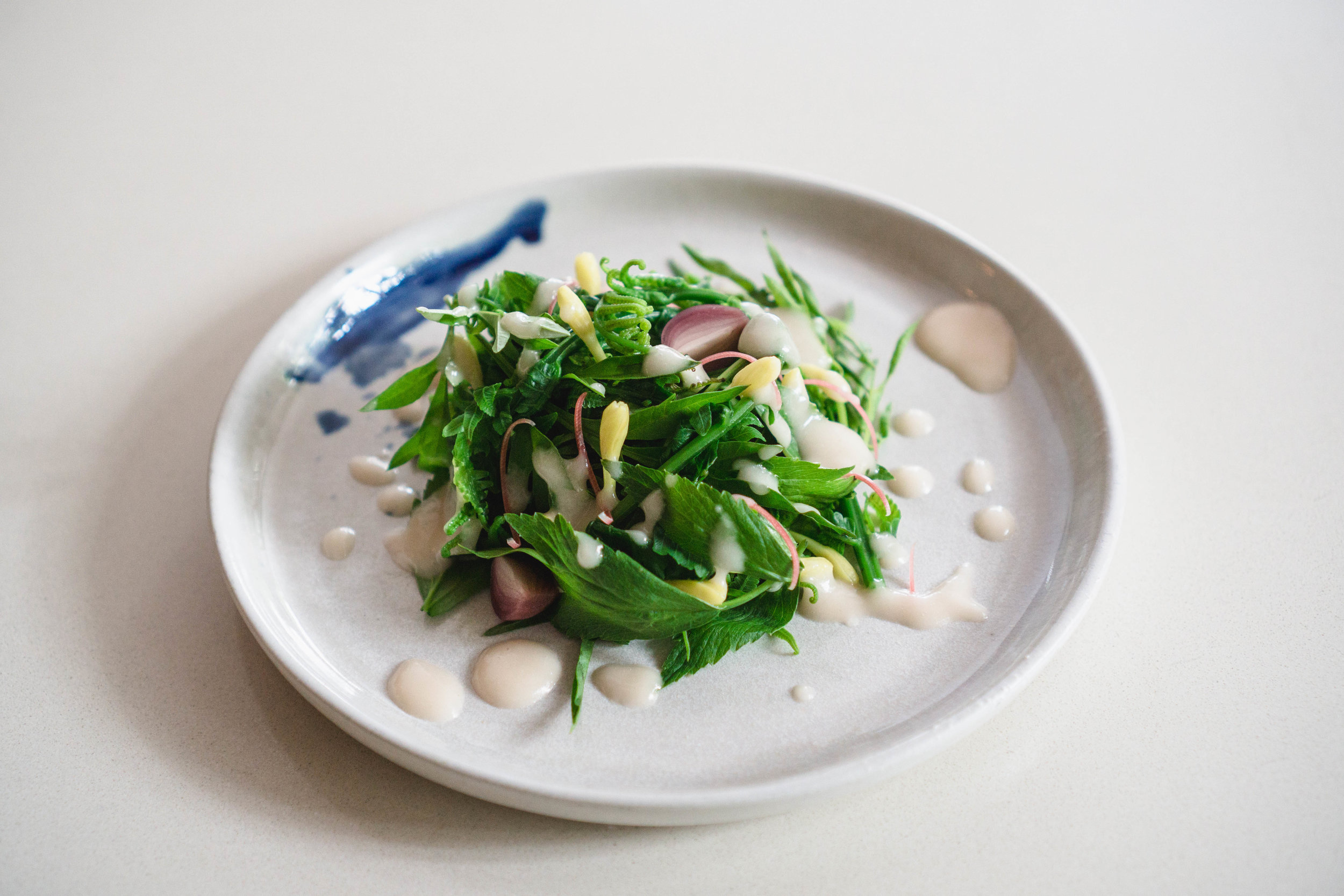Paku Fern Salad with Torch Ginger Lily Dressing
Salad greens are curious things. On their own—cos lettuce, romaine, icebergs, even endives—they have the subtlest taste. Put them together in a salad, and they act more as volumisers, as sauce-carrying textural padding, as crunchy bursts of moisture more than anything else. So in most salads, it’s the dressing that does the heavy lifting when it comes to flavour.
Well, that salad axiom is true for if we’re talking about Western salads. After all, you rarely hear people exclaim how tasty the corals of lettuce are in their salad, nor do you hear salads ever ordered for the particular mix of mizuna and mache in them.
In Malaysia though, our ‘salads’—if you can even call them that—are built with greens chock-full with flavour . Think of the herbaceous ulam raja, sweet paku ferns, minty kesom, and bittersweet four-angled beans and banana blossoms. In Nusantara cuisine (the mother of many Southeast Asian cuisines), salad greens have their own culinary category; Over here, we call them ulam. On top of the crunch and textural balance they bring to dishes (like typical salad greens), ulam, on their very own, are always bursting with flavour. In fact, comparing them to salad leaves might seem like an insult. Perhaps ‘pre-chopped salsa verde’ would be a better descriptor.
With plucky salad greens like these, you’d think we would go light on the dressing. But no. In Malaysia, ulams are dipped and eaten with fiery sambals flecked with birds eye chillies, slathered in stinky tempoyak (fermented durian), and tossed through with chilli, cincalok (fermented shrimp), and the juice of calamansi limes.
Now I’m not one to always go ham on these sauces and ‘dressings’. After all, there’s only so much tempoyak one can stomach before our stomachs terkoyak. (Now there’s a Malay joke that will fall flat for most readers of this blog, haha.)
So most of the time, I’d rather have my Malaysian salads with more conventional dressings. Honey mustard is a quick go-to, Kewpie’s sesame dressing never disappoints, and even a simple balsamic vinaigrette just works. But now and then, as with the spirit of this blog, I like to stray away from the norm, and whip up a wacky dressing.
So here’s one. It that has all the trappings of a typical (read: non-Asian) salad dressing—an emulsified slurry of honey, mustard, lemon, bound together by a tub of oil. But for that bit of Asian wackiness, I infused the dressing with our cuisine’s most functional flower—bunga kantan, anglicised as the torch ginger lily. (Such an elegant, apt name!) It’s aromatic, elevatory, and does juicy justice to ulam.
So step aside, Cobb, Caesar, and Waldorf, there’s a new salad in town.
Paku Salad with Torch Ginger Lily (Bunga Kantan) Dressing
Serves 3-4
Ingredients
Bunga kantan dressing
1 torch ginger flower (bunga kantan), save 2 petals for garnishing
2 lemongrass stalks
zest of 3 lemons
250g sunflower oil, or any other neutral oil
1 tablespoon sunflower oil
1 red onion, diced
4 cloves garlic, finely chopped
juice of 3 lemons
½ teaspoon salt, or more to taste
1 tablespoon honey
½ tablespoon dijon mustard
Salad greens
1 large bunch paku fern
1 dozen papaya blossoms
2 torch ginger flower petals, sliced thinly
1 small bunch (~5 stalks) ulam raja
1 small bunch (~5 stalks) selom leaves
Garnish
freshly cracked black pepper
4-6 pickled shallots, quartered, optional
Directions
Roughly bruise and chop up the torch ginger flower and lemongrass stalks. Place this in a pot, together with the lemon zest and sunflower oil. Place this over a low heat, and heat until 80°C, or until you start to see really tiny bubbles start to form around the chopped up solids. Then take it off the heat and let it cool down. When the oil is cool, strain it through a sieve and discard the solids.
Meanwhile, in a pan, heat up the tablespoon of oil over medium-low heat, and add in the diced onion and sweat it down for 10 minutes, until the onions are softened and translucent. Add in the garlic and cook for another 5 minutes. Transfer the cooked onion and garlic into a blender, add in the lemon juice, salt, honey, and mustard, then blend it all until super smooth! Then, put the blender on low, and slowly drizzle in the infused oil to emulsify it with the sauce. (If your blender doesn’t allow you to blend and drizzle at the same time, add in the oil in 4-5 batches, blending it until smooth in between each batch.)
Now onto the greens! Ready a pot of salted boiling water, salty as the sea, and an ice bath. Cut the paku stems into 4-inch long pieces, then blanch it in the boiling water for about 15 seconds, until just tender. Then, remove the paku from the water, and immediately plunge into the ice bath. When the paku is completely cooled, remove them from the water and dry with a salad spinner or with kitchen towels. Repeat the same blanching and shocking-in-ice process for the papaya blossoms, but skip the drying step, just sieve it out of the ice water. (Blanching will help remove some of its raw bitterness.)
Toss together the blanched paku, fresh ulam raja, selom leaves, papaya blossoms, and sliced torch ginger flower petals (reserved from before). Then, dress it with a torch ginger flower dressing, then garnish it with a couple of cracks of black pepper, some pickled shallots, and serve! (Alternatively, if you want your salad to look a little boujie like I did in the photos, plate the salad in a loose mound, and meticulously place on the papaya blossoms and torch ginger flower, before drizzling the dressing over it.)








